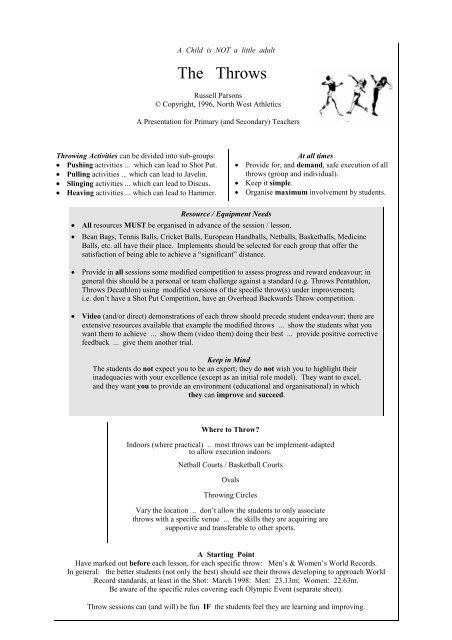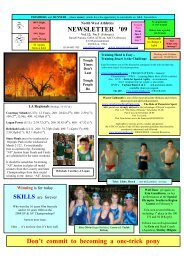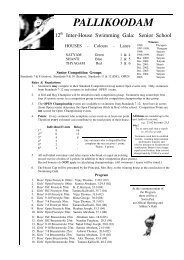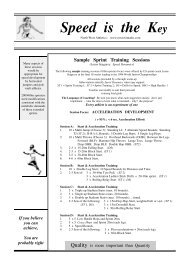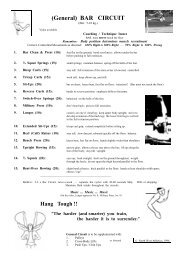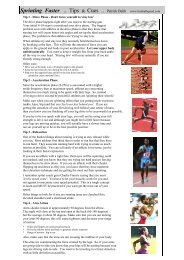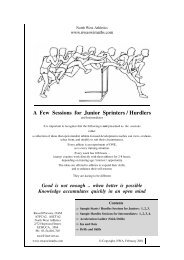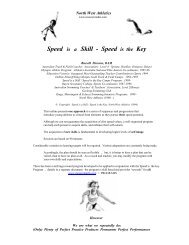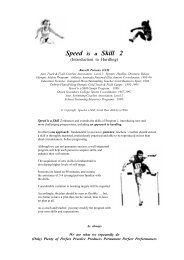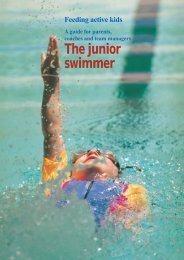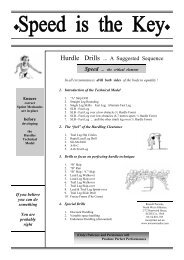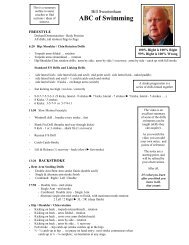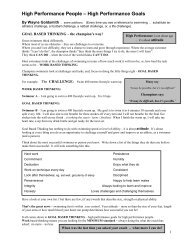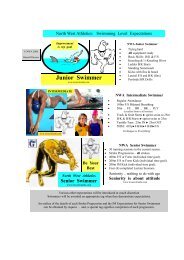The Throws - North West Athletics
The Throws - North West Athletics
The Throws - North West Athletics
Create successful ePaper yourself
Turn your PDF publications into a flip-book with our unique Google optimized e-Paper software.
A Child is NOT a little adult<br />
<strong>The</strong> <strong>Throws</strong><br />
Russell Parsons<br />
© Copyright, 1996, <strong>North</strong> <strong>West</strong> <strong>Athletics</strong><br />
A Presentation for Primary (and Secondary) Teachers<br />
Throwing Activities can be divided into sub-groups:<br />
• Pushing activities ... which can lead to Shot Put.<br />
• Pulling activities ... which can lead to Javelin.<br />
• Slinging activities ... which can lead to Discus.<br />
• Heaving activities ... which can lead to Hammer.<br />
At all times<br />
• Provide for, and demand, safe execution of all<br />
throws (group and individual).<br />
• Keep it simple.<br />
• Organise maximum involvement by students.<br />
Resource / Equipment Needs<br />
• All resources MUST be organised in advance of the session / lesson.<br />
• Bean Bags, Tennis Balls, Cricket Balls, European Handballs, Netballs, Basketballs, Medicine<br />
Balls, etc. all have their place. Implements should be selected for each group that offer the<br />
satisfaction of being able to achieve a “significant” distance.<br />
• Provide in all sessions some modified competition to assess progress and reward endeavour; in<br />
general this should be a personal or team challenge against a standard (e.g. <strong>Throws</strong> Pentathlon,<br />
<strong>Throws</strong> Decathlon) using modified versions of the specific throw(s) under improvement;<br />
i.e. don’t have a Shot Put Competition, have an Overhead Backwards Throw competition.<br />
• Video (and/or direct) demonstrations of each throw should precede student endeavour; there are<br />
extensive resources available that example the modified throws ... show the students what you<br />
want them to achieve ... show them (video them) doing their best ... provide positive corrective<br />
feedback ... give them another trial.<br />
Keep in Mind<br />
<strong>The</strong> students do not expect you to be an expert; they do not wish you to highlight their<br />
inadequacies with your excellence (except as an initial role model). <strong>The</strong>y want to excel,<br />
and they want you to provide an environment (educational and organisational) in which<br />
they can improve and succeed.<br />
Where to Throw?<br />
Indoors (where practical) .. most throws can be implement-adapted<br />
to allow execution indoors.<br />
Netball Courts / Basketball Courts<br />
Ovals<br />
Throwing Circles<br />
Vary the location .. don’t allow the students to only associate<br />
throws with a specific venue ... the skills they are acquiring are<br />
supportive and transferable to other sports.<br />
A Starting Point<br />
Have marked out before each lesson, for each specific throw: Men’s & Women’s World Records.<br />
In general: the better students (not only the best) should see their throws developing to approach World<br />
Record standards, at least in the Shot: March 1998: Men: 23.13m; Women: 22.63m.<br />
Be aware of the specific rules covering each Olympic Event (separate sheet).<br />
Throw sessions can (and will) be fun IF the students feel they are learning and improving.
Basic Throwing Movements<br />
While I do not advocate the implementation of Olympic <strong>Throws</strong> without modification in primary school,<br />
and, in early secondary programs, a carefully graduated and rewarding progression in throwing skills will help<br />
young athletes master the throws in later years, and, will enhance their fundamental motor skills.<br />
Offering a diverse range of movements motivates the youngsters, enabling them to more directly<br />
associate their improving co-ordination, flexibility, and power skills with those of their chosen sport(s).<br />
<strong>The</strong> following principles apply to a certain degree in all four Olympic <strong>Throws</strong>: Shot Put, Discus, Javelin,<br />
and the Hammer Throw.<br />
1. Legs First ... Arms Last.<br />
2. <strong>The</strong> lower half of the body is accelerated ahead of the upper half. This has linear application in the<br />
Javelin and O’Brien Shot Technique, and is applied rotationally in the other throws.<br />
3. Weight transfer from the right foot and leg ... to the left. (Right-hand throw)<br />
4. <strong>The</strong> left side is braced, and the right side accelerates around it during the final delivery.<br />
5. <strong>The</strong> implement is always released from a stretched high position.<br />
6. <strong>The</strong> thrower starts low(er) and finishes higher.<br />
Strongly Recommended<br />
Sufficient implements to allow<br />
(at least) one between two.<br />
Plan carefully the location of students<br />
in their throwing positions<br />
Group Organisation<br />
All Throw / All Retrieve<br />
ALL THROW .... ALL RETRIEVE<br />
• Check all implements; are they in sound condition<br />
(especially if an improvised implement)?<br />
• Throwing Area: should be well-defined (roped-off ... people do stray into landing areas).<br />
• Teacher / Coach: ensure no person is in the throwing area or probable line of flight.<br />
• All observers (incl. non-throwing students-athletes) to be well clear, and to the rear.<br />
• All Throw ... then (on coach command) ... All Retrieve.<br />
• All implements to be carried back to the throwing circle or line.<br />
• A cloth or towel should always be on hand to dry and/or clean implements.<br />
All Expectations Apply to Modified Activities, Games, and Competitions<br />
Included with this handout are details of Medicine Ball <strong>Throws</strong> (these can be adapted, e.g. various weights;<br />
Medicine Ball can become Soccer Ball; ... you decide what is appropriate and will enable each student to<br />
enhance their skills and derive satisfaction and self-esteem.<br />
<strong>The</strong> <strong>Throws</strong> Decathlon can (and should) be adapted ... set your own standards.<br />
Do not strictly apply Olympic Rules ... have the youngsters seek out the (modified) throw they can do best.
A Selection of Activities<br />
Equipment: European Handball, Netball, Soccer Ball, Medicine Ball, Vortex ...<br />
(Some) Cues<br />
1. Push from Chest.<br />
1.1 Chest Push at a Wall .. above target line; Keep elbows up; full extension of<br />
angle of release approx. 45°.<br />
arms, not a flick of the wrist.<br />
1.2 Chest Push for Height<br />
1.3 Chest Push Throw to Partner<br />
2. Variations:<br />
Ball goes<br />
further from a higher<br />
2.1 Kneeling Push (both knees)<br />
platform.<br />
2.2 Kneeling .. L. foot forward<br />
2.3 Kneeling .. R. foot forward<br />
2.4 Seated Soccer Throw<br />
2.5 Kneeling Soccer Throw<br />
2.6 Standing Soccer Throw<br />
2.7 Standing (side on) .. push throw to partner or for distance.<br />
Standing: straighten knees, then push out; keep feet on<br />
ground.<br />
3. One Hand Activities (Bean Bag / Tennis Ball / Cricket Ball / Weighted Tennis Balls)<br />
3.1 Seated<br />
3.2 Kneeling Hold bean bag under chin with<br />
a<br />
3.3<br />
Standing<br />
(feet by<br />
side) ..<br />
push<br />
throw<br />
for distance; high elbow; encourage a strong<br />
Don’t try to achieve too much in any one session ... a small number of<br />
throws, done well, challenging both sides of the body, is a an<br />
excellent outcome ... base your selection and progression on each<br />
student succeeding before advancing to complex skills.<br />
bend knees & push throw; preferred & non-preferred.<br />
Each No. 1 has a sock and stands front on to the<br />
direction of throw .. sock pushed in shot put fashion<br />
(not thrown overarm).<br />
Score 5 points for crossing the first line, 6 for the<br />
second, etc.<br />
Teacher quickly notes each score.<br />
No. 1’s retrieve sock; hand to No. 2 student.<br />
Team with highest combined score wins.<br />
arm action; follow through to<br />
3.4 Standing Tennis Ball Throw (L. & R. foot forward ) “see it go”.<br />
3.5 Standing Tennis Ball Throw (L. & R. foot forward) ..<br />
over bar / fence<br />
“Clean palm; dirty neck”<br />
4. Sock<br />
Put<br />
Important<br />
<strong>The</strong> handout is a summary of a few ideas ... the drills shown are not “the” drills. Teams<br />
Of greater importance is the experience of “having-a-go”, experimenting, discussing,<br />
exchanging ideas, and adapting those ideas to the specific needs of your students.
Examples of Throwing Movements<br />
Forward Overhead<br />
Schwanbeck Movement<br />
Overhead Backwards<br />
Standing One-Hand Push<br />
Kneeling Overhead<br />
Double Hand Sling<br />
Soccer<br />
Kneeling Single Hand Throw<br />
Backwards Between Legs<br />
<strong>The</strong> examples of throwing movements presented<br />
Throw for Height / Sit / Stand / Catch<br />
Caber<br />
above are just that ... examples.<br />
Challenge yourself to simulate aspects of the throw your wish to focus upon.<br />
Choose an appropriate implement and weight.<br />
Also, ensure students warm-up in a general and specific sense for the activities you are presenting to them.
Useful Resources<br />
Run - Jump - Throw*: Play It Cool Coaching Manual; NZ KiwiSport; National Sport Information Centre,<br />
PO Box 176, Belconnen, ACT, 2616.<br />
<strong>Athletics</strong> Victoria:<br />
Development Officer, <strong>Athletics</strong> Victoria, Olympic Park, Swan Street, MELBOURNE, 3004.<br />
Ph: 03-9428-8195; Fax: 03-9427-9183<br />
<strong>Athletics</strong> Towards 2000 Teachers Resource Materials*: 8 Booklets:<br />
1. Marking an <strong>Athletics</strong> Field; 2. <strong>Athletics</strong> Competition - Organisation and Rules;<br />
3. Teaching Manual - Track Events; 4. Teaching Manual - Jumps;<br />
5. Teaching Manual - <strong>Throws</strong>; 6. Physiology of Performance in <strong>Athletics</strong>;<br />
7. Nutrition for Athletes; 8. <strong>Athletics</strong> Injuries.<br />
<strong>Athletics</strong> Australia: Suite 22, Fawkner Towers, 431 St. Kilda Road, MELBOURNE, Vic., 3004<br />
* I understand that introducing students to athletics is only one of the important tasks you must address in your<br />
curriculum; I can help with pre-prepared resources. Do not concern yourself with these resources being<br />
“dated” ... they present ideas and teaching progressions that can be understood and adapted by teachers.<br />
Various videotapes are available .. contact me for details on where to locate and/or borrow these resources.<br />
Russell Parsons<br />
<strong>North</strong> <strong>West</strong> <strong>Athletics</strong><br />
2/72 Hopwood Street,<br />
ECHUCA, 3564<br />
Ph/Fax: 03-54-801-705<br />
Other Materials included with this Presentation<br />
Sample Throw Sequences: Discus / Shot / Javelin (videotape)<br />
Sample Throw Sequences ... photocopy<br />
Sample Medicine Ball <strong>Throws</strong> (videotape)<br />
Initial Development of Throwing Movements (<strong>Athletics</strong> Towards 2000)<br />
Performance-based Scoring Systems for <strong>Athletics</strong> .. Keeping It Close<br />
<strong>Throws</strong> Decathlon<br />
Sample Record Sheet for <strong>Throws</strong> Decathlon<br />
Selected Throwing Games for Junior Athletes<br />
Russell Parsons<br />
<strong>Athletics</strong> Victoria: Country Coaching Co-ordinator (Ouyen-Mildura, 1988-95; Echuca, 1998-)<br />
<strong>Athletics</strong> Australia: Olympic Athlete Program Elite Juniors Co-ordinator, 1995-96<br />
<strong>Athletics</strong> Australia: National Juniors (U20) Head Coach, 1995-96<br />
Debbie Flintoff-King Olympic Gold Track & Field Camps Program: 1992-1995<br />
Education, Victoria: Inaugural Most Outstanding Teacher Contribution to Sport, March 1994<br />
Leading Teacher and Co-ordinator of Sport, Ouyen Secondary College, 1967-1998<br />
Australian Track & Field Coaches Association<br />
Australian Swimming Coaches Association
Examples of Throwing Movements<br />
3. Schwanbeck Movement<br />
(both sides)<br />
1. Overhead Backwards<br />
2. Forward Overhead – Soccer<br />
6. Standing One-Hand Push<br />
(both sides)<br />
4. Double Hand Sling<br />
(both sides)<br />
5. Kneeling Overhead<br />
9. Kneeling Single Hand Throw<br />
(both sides)<br />
7. Backwards Between Legs<br />
8. Throw for Height / Sit / Stand / Catch<br />
Rocky Half Twist: Standing / Kneeling / Seated<br />
10. Caber<br />
<strong>The</strong> examples of throwing movements presented above are just that ... examples.<br />
Challenge yourself to simulate aspects of the throw your wish to focus upon.<br />
Choose an appropriate implement and weight.<br />
Also, ensure students warm-up in a general and specific sense for the activities you are presenting to them.


